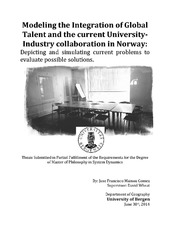| dc.description.abstract | Despite the yearly increment on the population of international students [1], just about 46.8% of them take their first professional job in Norway after graduation. The above data neglects ERASMUS and exchange students. In addition, according the Norwegian labor and welfare department, about 50,000 foreigners were needed to supply Norway's need of high skilled labor force in 2012 [2, 3] and projections indicate this trend will remain [11]. Moreover, the university-industry collaboration has been linked to the transition of graduate international students to the Norwegian labor market and it seems that universities cannot easily meet the expectation and needs for both, private and public firms, in terms of high skilled workers [2, 8]. Among the reference literature some ideas and possible solutions can be found: 1) A statistical report about the integration of global talent in Norway suggests that one way to supply the need of high skilled labor force is by hiring Global Talent [2]. 2) Industry claims the university labors itself when bringing international students; University looks for its own interest [2, 3]. 3)The cooperation between University and Industry in Norway has been gradually increasing when it comes to R&D, but when it comes to teaching and specific program there is still to keep mutual university-industry agreements alive and stronger [8,22]. Could the integration of GT to the Norwegian labor force crucial to activate the exponential growth of the expected university-Industry collaboration? How? A framework for depicting and simulating the transition of international graduate students to the Norwegian labor with special attention to the unemployment amount them, the huge demand of skilled worker in Norway, and University-industry collaboration has been successfully developed using stock and flow diagrams to show how the problem develops over time and what are the likely consequences of both the current structures and the suggested solutions. The best results are achieved by combining all suggested ideas and turned into a combined policy: Industrial University Programs". The government, University, and industry could make the most of global talent while also solving their own needs; Norway could be ahead as Knowledge-based Economy. To prevent clogging from massive resistance to the Industrial University Programs: The cooperation, and role between university, industry must be very clear. University programs most not benefit all industrial needs, and the university should keep autonomous in the research line. Industry most support student taking program that already exist in the university curricula and that closely matches their need. Some combined programs can be designed in the case of CRIs. Enabling. We provide Industry with the labor it needs, but it most cooperate by supporting university's existing programs rather than trying to residing curricula. University will be provided with extra funds, but it should be also more selective when admitting new students to match the student's professional profile to industry need. Industrial Programs do not represent expenditure for the government in terms of funding, or taxation, or changing constitutional laws. We are creating a new monopoly called: Industrial Programs that is or becomes subject to Allied control between the government, industry and university. | en_US |
